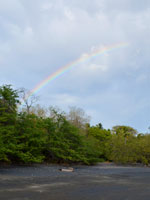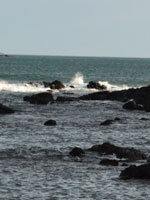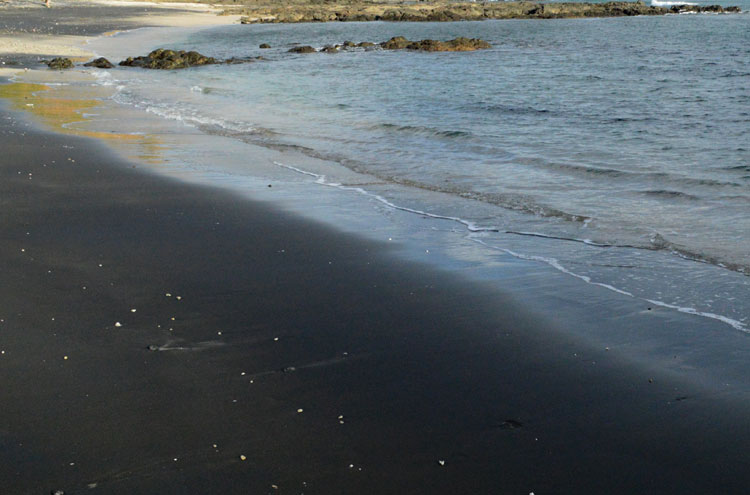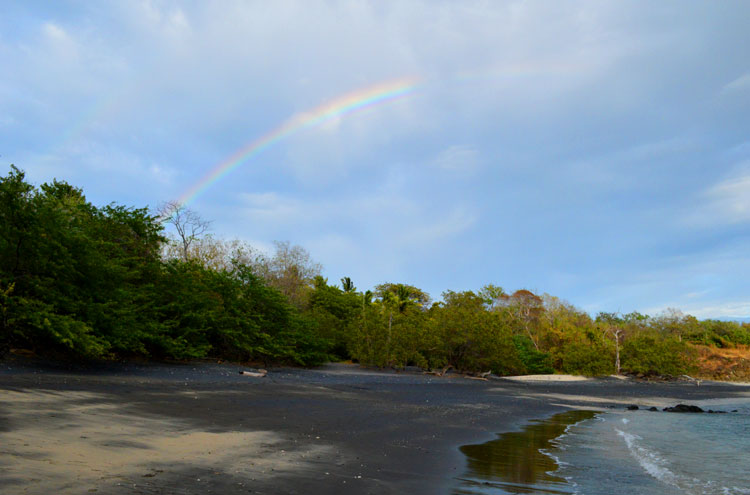

|
We had a little bit of leisure time today and the biologists arranged a few different activities for the volunteers, so we can get to see a little bit of the area. In the afternoon, a group of us took the van up the road a short distance and came to a parking lot near the beach. As we walked onto the beach, I realized that we were at the very northern end of Playa Ventanas, the exact spot I had been with Shannon on patrol the night before.  The black sand of Playa Carbón is reveals the volcanic origin of the surrounding rocks From Playa Ventanas, we hiked a small trail through the forest and came out at Playa Carbón, a secluded beach studded with volcanic rocks that gave the sand a dark black hue. The heat of the day was even more intense as we crossed the black sand; we felt like fire walkers on a pilgrimage to nirvana. We soon found a place in the shade of the acacia trees and threw down our towels. Then we put on our snorkeling gear and jumped in the ocean. The water felt so good, with a temperature that eased the sweltering heat. There were a number of volcanic outcrops along the beach that formed underwater canyons, providing a home to small groups of brightly colored fish. The canyons were a maze of passageways through an otherworldly landscape that completely obliterated my sense of direction. After exploring the underwater canyons and marveling at the sea life, I headed back toward the shore. Upon emerging from the ocean, I looked up at the trees beyond the beach and beheld a stunning rainbow forming a graceful arc across the sky. This gave me a sense of hope for an exciting night ahead of us.  Rainbow over Playa Carbón After dinner at Kike's (arroz con pollo - rice with chicken), we had a little time to relax and get ready for patrol. Our start time on the beach changes each night, as the high tide gets a little bit later and later. For this night, we were set to start at 8:10 pm, three hours before high tide, which was around 11 pm. The normal schedule is three hours before high tide and three hours after high tide, but everything changes if we find a turtle. I started off the night working with Nathan, the field manager of the station. We formed the north team, patrolling the northern end of Playa Grande. Together with the south team, we drove to an entrance to the national park, at marker #25. From there, the south team swept down to the end, which is marker #36, while we swept in the opposite direction up to the Hatchery, at marker #6. When we got to the Hatchery, we relieved the Ventanas team and spent some time watching out for raccoons. We weren't at the Hatchery long before we had an encounter with the raccoons. Nathan and I heard something in one corner of the enclosure, then heard an even louder rustling in the vegetation at the opposite corner. The raccoons are smart enough to send out a scout to try to distract us, while the rest of the gang prepares for a strike. They've tried this strategy before though, so Nathan was prepared. He stomped and whistled to scare them off, and I only got a brief glimpse of one of them disappearing into the surrounding vegetation. There were a couple of buckets of leatherback hatchlings in the Hatchery and it was time for them to be released to the ocean. Nathan assigned the task of releasing them to me, which was a very exciting thing to see. He showed me the place on the beach to start, about 10-20 meters up from the surf line. I turned the buckets over and let the turtles come out on their own, which they did right away. They made their way to the ocean at varying speeds; one hatchling was determined to get there right away, while some of the others straggled behind. Sea turtle hatchlings tend to aim for the "brightest light on the lowest part of the horizon," which in a purely natural world would be the white cresting waves coming in from the ocean. Some of the hatchlings may have been confused by the distant lights of town and seemed to be heading off in that general direction. We kept a close eye on them to make sure they didn't end up wandering the streets of Tamarindo and getting into trouble. I followed the leader, as Nathan said he was probably the "one in a thousand." For all the leatherback hatchlings we have seen in the past few days, only one in a thousand of them will survive to adulthood. It's a frustrating statistic, and given the challenges they face, it's amazing that even that one in a thousand can make it. Predators, diseases, trash in the ocean, fishing lines, fishing hooks, boat propellers, the list goes on and on of the obstacles these creatures need to overcome. I watched as the first hatchling reached an incoming wave and saw him disappear into the ocean. The wave brought in a piece of bioluminescence, which seemed to serve as a symbolic lantern to guide the little hatchling out to sea. He was soon followed by all the rest of the hatchlings; one by one they found their way to the surf and took off on their new lives. Nathan and I walked carefully around the beach with our red lights, making sure all the hatchlings were on their way and that there weren't any stragglers. Our relief team arrived at the Hatchery, so Nathan and I continued our sweep of the north end of Playa Grande. We soon ran into a couple of buscadores, or "people who look for." These are locals who work with the tour guides to find out when a turtle has come up on the beach. The tourists pay $27 each for a chance to see a nesting sea turtle and some of that money goes toward the Leatherback Trust to help with conservation efforts. Some of the buscadores are former poachers, but now they work together with us in a way that benefits the local economy and helps educate the public about turtle conservation. We swept down to marker #21 and then turned around to head back north. We passed each of the two buscadores again, even though it was getting late. We figured there must be a very determined tour group that really wanted to see a turtle that night. Then we got a call over the radio that there was a black turtle at Playa Ventanas, right next to the big rock that forms the gateway to the beach. Nathan is working on a research project examining barnacles and other parasites that attach themselves to black and ridley turtles, so he wanted to take a look at this one. We walked up the length of Playa Grande and through the gateway onto Playa Ventanas. We found Heather the biologist and Bill the volunteer, observing the turtle from a distance. The turtle wasn't nesting, but just wandering erratically around the beach, which is common behavior for a black turtle. Bill was the volunteer who was there when the turtle was found, so it was "his turtle." He stayed with Nathan to examine the turtle and I went back down the beach with Heather to continue our patrol. As we got back onto Playa Grande, we got a call over the radio that there was a baula at marker #21, which is the dividing line between the territory covered by the north team and the south team. Arie, the biologist I had worked with on the first night, and volunteer Sally, were waiting for us at marker #21, while the turtle was busy excavating her nest. Heather gave me some new Spanish vocabulary that I never would have known had I not been in this very specific place. The process of excavating a nest is hacer la cama, or "to make the bed." The turtle was just to the north of marker #21, which meant she was "my turtle" and I got to "work" her. Once the nest was ready and she started laying eggs, it was my job to count the eggs as they dropped into the nest. When a leatherback lays eggs, the process of counting them is a little different than with an olive ridley, which I had done on the first night. A leatherback will take one of her powerful hind flippers and cover up the nest while she is laying eggs, making it difficult to get a good view. So I reach down with the same hand that holds the counter, and gently hold the flipper to one side so I can see. This turtle presented some challenges. She had moved up onto a steep berm and turned around to face the ocean, which meant I had to lay down on an incline behind her. Unlike the olive ridley, which seemed to drop an egg every 8-10 seconds, the leatherback dropped them sporadically, sometimes one at a time, sometimes three or four at a time. I had to watch carefully to get an accurate count, and also had to watch out for false eggs, which are known as SAGs (shelled albumen globes). These are eggs that do not have an embryo inside and so they are not counted. I focused on watching the eggs carefully, trying to ignore the sweat dripping down my face and the sand fleas hopping around my arms. After about 30 eggs were laid, I inserted a thermal couple into the middle of the pile of eggs. This device measures the temperature of the nest, which can be checked on a regular basis throughout the incubation period. After the turtle finished laying the eggs, she slowly and methodically begins to fill in the hole with sand. The hole is about 50 centimeters deep, a little more than a foot and a half, so this can take a while. I was done with the count, so I turned off my red light to watch her more discretely. It was an amazing sight to behold, this gigantic beast directly in front of me, slowly working to fill in her nest. I looked over the mass of her body, which is a carapace, a thick leathery tissue that is connected directly to the animal's bones. Leatherbacks are the only sea turtle that do not have a hard bony shell. In front of her the waves were crashing in, which must have been a beautiful sight to her. Above were the billion stars that shine so brightly here, with Orion standing guardian immediately in front of her. I felt truly overwhelmed by the universe at that moment. In the quiet darkness, I suddenly realized that there were a bunch of kids sitting right next to me. This must have been the tour group had that the buscadores were working with, and they showed up while I was counting the eggs. Most of them were very young, probably elementary school students, and I was impressed at how quiet and respectful they were. This was a good example of wildlife conservation and education coming together to achieve a common purpose. While I had been counting the eggs, Arie scanned the turtle's tags. Sally helped Arie with the measurements: the width of the carapace, the length alongside the main central ridge down the back, and the length of the ridge itself, which includes the tail. I usually try to pay attention to the latter measurement, and in this case she was 158 centimeters long, a little more than five feet. Heather and I continued our sweep up the beach after we finished working the turtle. We hadn't gone far when I spotted the familiar tracks in the sand of another baula. We followed them up the beach and found her already in the process of laying her eggs. There was no sense in trying to count them this time, so we carried out the other tasks of inserting the thermal couple, scanning the tags, doing the measurements (157 cm, just over five feet), and picking off barnacles from her carapace. Heather noticed that this turtle was missing her hind left flipper and said "this is Gracie!" We usually don't give the turtles names, but Arie had told me the story of Gracie my first night on the beach. Arie had a dog named Grace that had lost one of its legs and so when she first encountered this turtle earlier this year, she was especially intrigued by her. She started thinking of her as "Gracie" and followed her progress whenever she would show up on the beach. Having just heard the story a couple of nights before, I was honored to meet this three-flippered baula. While Heather recorded all the data, Gracie finished camouflaging the nest and slowly started to head back to the ocean. I followed her down, from a respectful distance, and sat down on the beach to watch her. It was quite a contrast from watching the tiny little hatchlings I had released earlier in the night. As Gracie reached the surf line, she began splashing with her powerful front flippers and soon disappeared under the waves. By this time it was long past our scheduled finishing time of 2:20 am, but we still had one more task to do. Nathan had worked a leatherback at marker #8 and we wanted to check on her before we headed back. We found her way up on the beach in an unusual location. She was right up against the fence of a beach house that had bright lights shining out across the sands. Baulas usually look for darkness when they are seeking out a nesting spot, so this was unusual behavior. It was about 4:00 am when I finally made it back home. I showered all the sand off and climbed into bed, physically exhausted but amazed at everything I had seen over the course of the night. I finally got to sleep while visions of baulas lumbering up the beach faded slowly away. |
||||
|
||||
|
© 2015 Michael Hanrahan
|